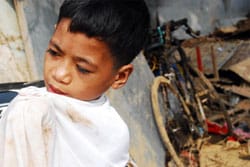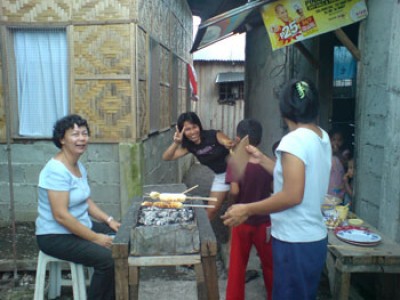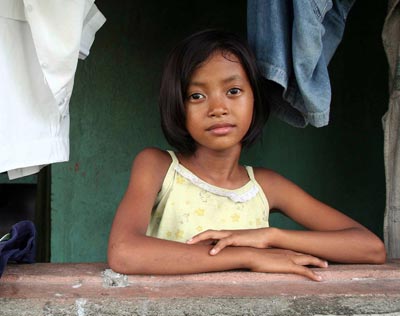Was My Sponsored Child Affected by That Crisis?
In a perfect world, here’s how the process would work:
Continue Reading ›Living in Two Worlds
How difficult is it for the Moody scholars to transition between the poverty of their homes and life in the U.S.?
What’s It Like Growing Up in Poverty?
Another clip from our video interview with the Moody Bible Institute scholars.
After watching it, will you sponsor a Leadership Development Program student? You can do so by yourself, but you can also do it as a group, with family, friends, co-workers, your small group, etc.
Who’s in Charge?
So, an emperor, a chief and a queen are all in a room together. The emperor is from Uganda. The chief is from the Dominican Republic. And the queen is from the Philippines. Who’s in charge?
God’s Agents of Change: Unscripted
In late July we interviewed our Moody Bible Institute scholarship recipients using questions you submitted here. We filmed the interview and will be sharing clips from the session with you over the next few weeks.
In the first clip, which is just over 13 minutes long, you’ll get to see how Richmond, Tony, Michelle and Jimmy interact with one another.
You’ll get a taste of the strength of their relationships with one another and with God.
And you’ll get a little insight into what Jimmy probably asked his sponsor when they met at Catalyst 2009.
Beyond getting to know them a little better, by learning what these agents of change are studying at Moody and why they chose their fields of study, you’ll also hear, among other things:
- Tony speak about his call to serve teenagers
- Michelle and Richmond share about their desires to develop strong Christian leaders in the Philippines and Uganda
- Jimmy relate what life was like before he was sponsored
Enjoy.
Marikina Foursquare Student Center After Typhoon Ketsana
Typhoon Ketsana, which struck the Philippines on September 26, damaged more than 1,500 homes of Compassion-assisted children and families, and nearly 20 student centers were affected by the storm.*
Ketsana hit the Philippines on a Saturday, the day when registered children gather at the student centers. But on September 26 not many arrived at Marikina Foursquare Student Center. Ketsana was already pounding hard.
However, some children did come.
Bernadette, the center director, fed them and instructed them to go home immediately. And as she planned to visit the homes of other children to give them some food because the floodwaters were rising fast, she was called by her own family. Her home was flooded too.
“What I have learned from this is not to look back on the possessions I lost, but rather focus on saving myself and my loved ones. On that day, I couldn’t attend to the needs of the children since my own home was in disarray.”
In the following days Bernadette reports that none of the children from her student center were hurt, although all of their homes were flooded, damaged in some way or destroyed completely.
The student center and its surrounding communities were completely submerged under water. And five days after the typhoon, homes and communities were still flooded, muddied, stinky and a mess.
Mirasol, a mother at the church, says,
“It is still a nightmare for me. I still vividly recall images of people being swept away by the water. I couldn’t sleep thinking that I was not able to help them as they were crying, as they were swept away towards the river. My child was crying the loudest, ‘Mother, Mother, the water is so high already!’”
Two of Mirasol’s children, Maribel and Dominic, are registered at the student center. They are safe but their home is still under water.
 Miguel, another child from the student center, says he was so afraid because he got separated from his father when his father took his mother to safety first, but could not come back for Miguel and his younger brother because of the dangerously strong current.
Miguel, another child from the student center, says he was so afraid because he got separated from his father when his father took his mother to safety first, but could not come back for Miguel and his younger brother because of the dangerously strong current.
Miguel and his brother were rescued by a neighbor, also a Compassion parent, as the boys jumped from roof to roof. They were reunited with their parents the next day at the church, but their tiny home was washed away completely.
Miguel’s father confesses,
“I pounded on my heart in anguish, crying. I was thinking of my boys all the time. I didn’t know what to do. I tried to look for them several times. I even waded back and forth in the water calling out for my sons.”
But despite the situation he and his family now find themselves in, Miguel’s father says,
“I won’t complain because I still have what truly matters.”
His family.
When natural disasters strike, Compassion’s Disaster Relief Fund provides sponsored children and their families with food, clothing and basic supplies to help rebuild their lives. Learn more about the Disaster Relief Fund.
*Editor’s note: In the wake of a disaster we contact each sponsor who has a child affected by that disaster. We do so once we receive details from the country office about the child. If your child was affected by either Typhoon Ketsana or Typhoon Parma, you will be contacted when we receive information about your child.

Would You Immerse Yourself in Extreme Poverty to Get a Job?
You know when you go on a mission trip that is a completely life-changing experience, and you come back all fired up? You just stared injustice in the face and realized you can actually do something about it. Your life takes on new purpose. You know that feeling?
Philippines Milestone: 50,000 Registered Children
“Why just now?” asks Pastor Joel. “Where was Compassion when I was just a child who had all the potential but did not have the money to go to school or to eat three square meals a day?”
Pastor Joel grew up on the remote island of Siquijor in the Philippines, which has long been known for magic and witchcraft, but Compassion in the Philippines only began partnering with churches in Siquijor this year.
Although Compassion reached the Philippines in the 1970s, we finally landed in the isolated island after 30 years!
In 2004, we began regularly updating our strategy map to identify the poorest and neediest provinces in the country with the fewest number of evangelical churches, and the list included Siquijor. (more…)
Josh Durias on Children in Poverty
We’d like to introduce you to Josh Durias and his photography.
Josh was born and raised in Seattle. He’s a father of two, and a husband to one.
We’re plagiarizing here … jes so ya know.
He’s a son of Philippine immigrants and grew up with his mother and father, sister, brother, grandmother, grandfather, two aunts, four uncles and five cousins (among other houseguests) in the 18 years he spent at home.
He enjoys people. And likes to laugh … even courtesy laughs … ha ha. 🙂
We met Josh through this blog. He sent us an e-mail with some photos he took on a Compassion trip. They are stunning. See for yourself.
We also asked him to share a little bit about the trip to help put the photos in context. We hope you enjoy Josh’s perspective on children in poverty.
Gearing up for my Compassion trip to Ecuador, I told my wife, “Ya know? In some ways I might have more in common with the Compassion kids than with the folks I’m traveling with.”
She needed a bit more convincing.
I reminded her that my cousin was a Compassion child in the Philippines, my mother grew up in a poor farming community in Zamboanga, and many of my family members are still living in situations like the ones I’ll see on the trip.
“Wow,” she replied. “I hope people can see that in your photos.”
With that, my challenge was set: Tell the stories of these kids as if they were my own family.
Back in June, I traveled with a group of donors to Quito, Ecuador. The first stop was Bernabe Student Center for a Child Survival Program (CSP) presentation. This was the same center where I met Edison and Paula.
Edison and his family opened up their home for us to see what typical living arrangements look like in this area of Quito.
After lunch with the family, the highlight of the day was Edison’s birthday cake. No, it wasn’t his birthday, but for Edison’s first five birthdays his family didn’t have the funds for a birthday cake. So on that day, Compassion sponsored Edison’s very first birthday cake!
We encouraged him to “go for it,” but Edison wanted us to slice the cake up for everyone to enjoy.
When we returned to the center, a little girl named Paula waited anxiously for one of the families on the trip – her sponsor family. She was shy, but excited about the meeting. Her sponsor family greeted her with open arms and grins from ear to ear, but what really broke the ice were the gifts.
The family unveiled (among other things) a “Dora the Explorer” blanket. Paula loved Dora.
From that point on hugs, smiles and tears of joy were shared by everyone in the room. To think, this is just the start of years of support.
The last center we visited (Jesus Rey de Reyes Student Center) was located in Otavalo. Here we met Jessica and her family and spent much of the afternoon doing typical tasks around their home.
A few of the members on the trip tried their hand at picking corn. Others worked the wool that the family used in weaving belts that were sold at the market. Some of the most brilliant colors and intricate weaving I’ve ever seen!
On the flight home, I realized how thankful I am. I am thankful for an organization like Compassion whose sole purpose is to release children from poverty.
I am thankful that kids like Edison, Paula, Jessica and my cousin can be given hope in places where there may be no hope. And I am thankful that I, the son of a poor farmer’s daughter, get to share the story of kids growing up in his own mother’s shoes and sharing them through photography.
Now He Smiles
In 2008, little Eric was the first child registered at Rio Tuba Learning and Development Center in the Philippines. I was there. And I recently went back to see how he is doing.
To reach Eric’s far-flung town, I traveled by plane, took a 30-minute motorcycle-taxi ride, and then a grueling six-hour bus ride on a dusty, monotonous rough road.
I was warmly received by Pastor Gwen, who immediately said she remembered my last visit. She also said Eric has improved much. His father, Benny, however, has been very elusive.
Pastor Gwen has tried several times to reach Benny to discuss matters about sponsorship, but he’s never home. His children always say he’s out looking for food.
 The next morning I saw Eric in his tutorial class at the student center and immediately noticed a big difference – he was smiling at me!
The next morning I saw Eric in his tutorial class at the student center and immediately noticed a big difference – he was smiling at me!
There was a toothless gap in his big grin, and I was very happy to see it.
I approached and asked if he remembered me from my last visit. He said no.
I observed Eric in class. He was the quietest and most well-behaved.
The other children were typically rowdy, but Eric went about his quiet way, listened to the teacher attentively, colored some drawings as told, and took his morning snack.
As in all student centers throughout the Philippines, Rio Tuba plans and conducts many activities for the children. The goal is to connect with each individual child so that each hears the Gospel and learns Bible stories and songs, is monitored for health, receives school tutorials, and is given a chance to just play, eat, enjoy, feel loved and feel safe.
Simply put, each child is given the chance to live a happy life so that all of them, like Eric, can begin to smile.
I learned that 6-year-old Eric comes to the center after his regular elementary school classes. He is in grade one. We grabbed a quick lunch, and it was time to meet Eric’s family again.
Pastor Gwen had briefed me on how the student center performed in its first year of partnership with Compassion. So naturally I wanted to know if all that she said was true for Eric’s family. (more…)
Remembering Roselyn
Several weeks ago, Compassion internally released a book communicating its brand, its mission and its character to employees worldwide. I eagerly flipped through the pages, as I always do, looking for photography by my co-workers.
On the second page was our mission statement, “Releasing children from poverty in Jesus’ name,” and a picture of Roselyn.

I remember the first time I read about Roselyn. It was my first month on the job. Edwin Estioko in the Philippines had written a story about her in September 2007: (more…)
A Young Activist
The problems of the Filipino youth are real – delinquency, early pregnancy, drug addiction, prostitution and gangs. In the crammed squatter community of Escopa in metropolitan Manila, these social ills are a way of life.
Kenh is one of the young people living in Escopa, and today he has a chance to help solve these problems. Kehn, 16, was recently elected as one of his neighborhood’s youth officers, and already he has initiated the distribution of free bags, pencils and papers to little children, using local government funds.
“I believe that education is the key to helping the youth and straightening their lives,” he says. “If only they will stay in school, then they will be drawn away from youthful evils.”
Kenh’s involvement with the local Youth Council is political in nature, but poverty is not just political rhetoric for Kenh. It is reality. (more…)


